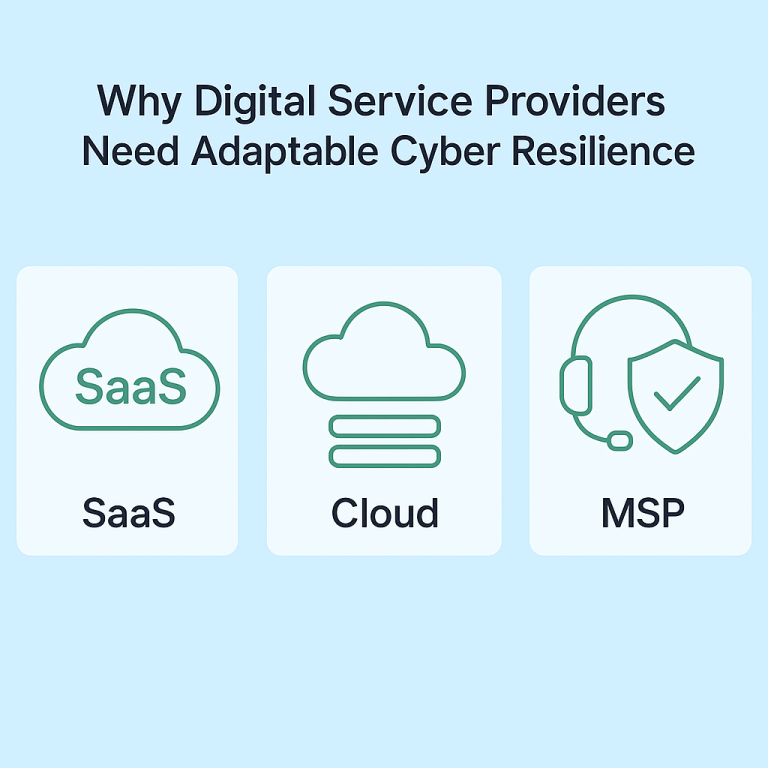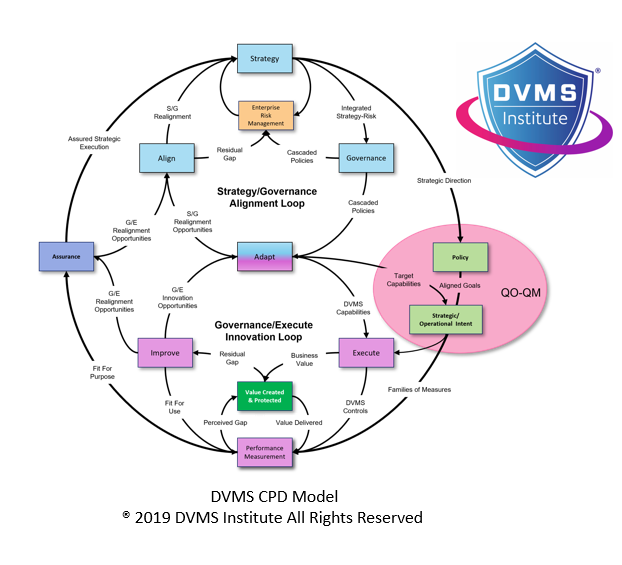Why Adaptive Cyber Resilience Must Be Baked Into All Digital Service Providers (DSP) Offerings
Rick Lemieux – Co-Founder and Chief Product Officer of the DVMS Institute
The modern digital economy depends on various digital service providers (DSPs), whose offerings underpin nearly every aspect of business and society. These providers—ranging from Software-as-a-Service (SaaS) companies to Infrastructure-as-a-Service (IaaS) providers, Platform-as-a-Service (PaaS) firms, Managed Service Providers (MSPs), cybersecurity vendors, and beyond—deliver critical capabilities but simultaneously introduce new avenues for cyber risk.
Software-as-a-Service (SaaS) providers are among the most widespread digital service companies. By hosting applications in the cloud and making them accessible over the internet, SaaS companies like Salesforce, Microsoft 365, and Zoom dramatically streamline business processes. However, the aggregation of sensitive customer data and widespread interconnectivity make them attractive targets for cyberattacks. A breach in a SaaS platform could propagate across thousands of client businesses almost instantly. Embedding a NIST-CSF and DVMS-based cyber resilience system allows SaaS providers to establish comprehensive governance, assurance, and innovation processes that address cybersecurity at the strategy level and throughout the service lifecycle. The NIST-CSF offers a structured yet flexible approach to identifying, protecting, detecting, responding to, and recovering from cybersecurity incidents. At the same time, the DVMS ensures that cybersecurity is not treated as an isolated concern but as integral to creating, protecting, and delivering digital value.
Infrastructure-as-a-Service (IaaS) companies, such as AWS, Microsoft Azure, and Google Cloud, deliver foundational computing services that countless businesses build upon. These providers support critical workloads for healthcare, finance, manufacturing, and more. A successful attack against an IaaS provider could jeopardize national security and economic stability. As such, IaaS providers must embrace the NIST-CSF’s tiered approach to risk governance, setting clear cybersecurity maturity goals (from Partial to Adaptive) while embedding the DVMS Z-X Model capabilities—Govern, Assure, Plan, Design, Change, Execute, and Innovate—across their operational environments. This ensures a balance between proactive threat defense and rapidly recovering and innovating after an attack, a hallmark of true cyber resilience.
Platform-as-a-Service (PaaS) providers offer environments for developers to build, test, and deploy applications without worrying about underlying infrastructure. Companies like Heroku, Google App Engine, and Red Hat OpenShift exemplify this model. However, the interconnected nature of PaaS systems can amplify vulnerabilities. If the platform layer is compromised, all applications built upon it may be at risk. The DVMS approach emphasizes concurrent creation and value protection, not treating security as an afterthought but baking it into the design and execution phases of product development. By overlaying the NIST-CSF onto platform operations and mapping outcomes through DVMS capabilities, PaaS providers can assure clients that their security posture evolves with platform innovation.
Managed Service Providers (MSPs) and Managed Security Service Providers (MSSPs) manage and protect customer IT systems on their behalf. Their privileged access to client networks makes them prime targets for adversaries. MSPs that suffer breaches can inadvertently compromise every organization they serve. Therefore, managed providers must adopt an integrated cybersecurity framework that treats resilience as a continuous, organization-wide goal. Through the combined lens of the NIST-CSF and DVMS, MSPs can assess gaps, drive improvements, and maintain cyber resilience by embedding strategic governance, continual learning, and systems thinking into every layer of service delivery.
Cybersecurity providers themselves, ironically, also face significant risks. Despite being defenders, cybersecurity firms are tantalizing targets for cybercriminals aiming to uncover vulnerability intelligence or tools. Adopting the NIST-CSF enables these organizations to establish transparent cybersecurity risk governance processes. At the same time, the DVMS ensures its operations are governed by strategic risk management and innovation-oriented continuous improvement. Cybersecurity vendors that internalize these principles do not merely provide services—they embody the cyber-resilient behavior they advocate for their clients.
The importance of integrating a cyber resilience system grounded in both NIST-CSF and DVMS stems from the need to move beyond traditional, reactive cybersecurity measures. Traditional cybersecurity often treats incidents as isolated events and compliance as an end state. However, today’s digital environment is characterized by constant change, sophisticated threat actors, and highly complex supply chains. A reactive or compliance-only posture is no longer sufficient. As emphasized in the DVMS model, actual resilience demands that organizations anticipate attacks, withstand disruptions, rapidly recover, and innovate despite adversity.
Using the NIST-CSF provides digital service providers with a language and taxonomy for cybersecurity risk management that aligns with enterprise risk management frameworks. It offers structured pathways for understanding cybersecurity posture (via Profiles), setting improvement goals, and benchmarking maturity against adaptable Tiers. Meanwhile, DVMS strengthens this by embedding resilience capabilities directly into how an organization governs, assures, plans, designs, changes, executes, and innovates. Doing so ensures that cyber resilience is not a “bolt-on” but an inherent characteristic of the business model.
Moreover, using a NIST-CSF and DVMS cyber resilience system enables providers to adapt to regulatory demands more effectively. Regulations like the SEC, DORA, NIS2, SOCI, SAMA, IMO, GDPR, and HIPAA, as well as various national cybersecurity mandates, increasingly require demonstrable, risk-based cybersecurity governance and resilience. Providers that align with these best practices are better positioned to navigate audits, mitigate fines, and maintain the trust of clients, regulators, and investors.
Finally, cyber resilience, founded on the NIST-CSF and DVMS approach, enhances competitive advantage. In a crowded marketplace, trust is a differentiator. Customers and partners are increasingly scrutinizing the cyber hygiene of the providers they engage with. Providers demonstrating a mature, structured, and evolving cybersecurity and resilience capability will win and sustain business in a volatile digital landscape.
Whether SaaS, IaaS, PaaS, MSP, or cybersecurity vendor, digital service providers must recognize that resilience is the foundation for enduring value. The NIST Cybersecurity Framework offers a proven structure for managing cybersecurity risks. At the same time, the Digital Value Management System ensures that cyber resilience and digital value protection are tightly integrated into every aspect of service delivery. Together, these approaches enable digital service providers to anticipate threats, maintain operations under duress, innovate continuously, and build lasting trust with customers and stakeholders. In a world where digital services are now the lifeblood of economic and social activity, cyber resilience is not optional but a prerequisite for survival and success.
About the Author

Rick Lemieux
Co-Founder and Chief Product Officer of the DVMS Institute
Rick has 40+ years of passion and experience creating solutions to give organizations a competitive edge in their service markets. In 2015, Rick was identified as one of the top five IT Entrepreneurs in the State of Rhode Island by the TECH 10 awards for developing innovative training and mentoring solutions for boards, senior executives, and operational stakeholders.
The DVMS Institute’s NIST Cybersecurity Framework Digital Value Management System® certified training programs teach Digital Service Providers (DSP) the skills to build a Holistic, Adaptive, and Culture-Powered Cyber Resilience Overlay System capable of proactively identifying and mitigating the systemic risks that impact digital business operations.
The NIST-CSF-DVMS positions cyber resiliency not as a technical function but as a strategic, enterprise-wide responsibility. This systems-based approach mandates engagement from top Leadership to Frontline Employees each fulfilling distinct responsibilities.
Enabling Resilience requires coordinated action across an enterprise’s Strategy, Governance, and Operational layers. Each of these layers contains unique roles that, when aligned and functioning cohesively, enable the organization to protect digital assets and adaptively manage digital business risks while delivering sustained digital value and resilience.
Enabling this unique and innovative approach to Adaptive Governance, Resilience, and Assurance DSPs can now comply with any government-mandated cybersecurity regulation (SEC, DORA, NIS2 etc.) or maturity model program (SCF, HITRUST, CMMC etc.).
® DVMS Institute 2025 All Rights Reserved




